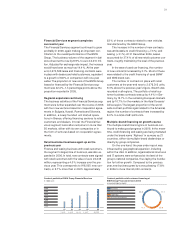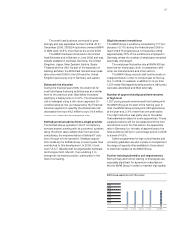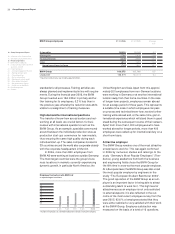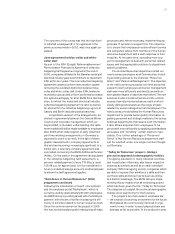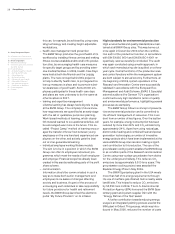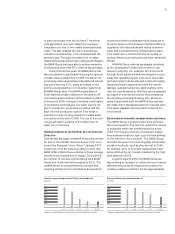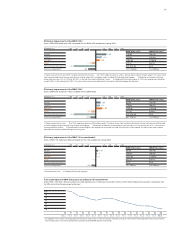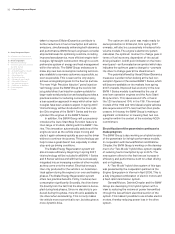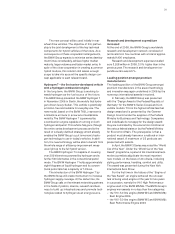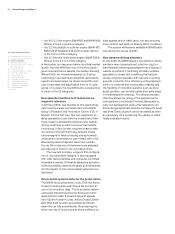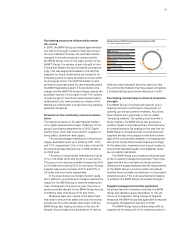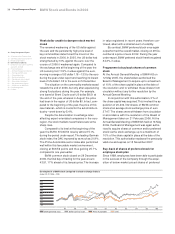BMW 2006 Annual Report Download - page 31
Download and view the complete annual report
Please find page 31 of the 2006 BMW annual report below. You can navigate through the pages in the report by either clicking on the pages listed below, or by using the keyword search tool below to find specific information within the annual report.
30 Group Management Report
10 Group Management Report
10 A Review of the Financial Year
12
General EconomicEnvironment
15 Review of operations
38 BMW Stock and Bonds
41 Disclosures pursuant to §289 (4)
and §315 (4) HGB
43 Financial Analysis
43 – Internal Management System
44 – Earnings performance
46 – Financial position
48 – Net assets position
50 – Subsequent events report
50 – Value added statement
53 – Key performance figures
54 – Comments on BMW AG
58 Risk Management
62 Outlook
53% of vehicles were delivered without protection
in 2006, compared with 42 % in the previous year.
The detrimental impact of protecting outside surfaces
was therefore significantly reduced.
The BMW Group long-term energy strategy –
innovation for lower fuel consumption
The BMW Group supports the Kyoto targets and
has been working intensively for years to reduce its
fleet’s fuel consumption. The energy strategy pur-
sued by the BMW Group is sub-divided into three
steps. In the short and medium term, the fuel con-
sumption of vehicles will be reduced by new, highly
efficient engine generations, active aerodynamics,
the use of innovative lightweight materials and intel-
ligent energy management within the vehicle. For
the BMW Group, all of these activities fall under the
concept of BMW EfficientDynamics. In the medium
term, the BMW Group is working on achieving addi-
tional consumption benefits through various meas-
ures such as increasing the electrification of the
drivetrain and hybridisation. From the BMW Group’s
perspective, the most sustainable technology in
the long-term is the use of hydrogen in the combus-
tion engine, since hydrogen can be produced from
various regenerative energy sources with practically
no CO2emission. In November 2006, the BMW
Group presented the BMW Hydrogen 7, based on
the BMW 7 Series, the first hydrogen-powered vehi-
cle to be offered in the premium segment.
Good progress made towards reducing fleet
consumption
In recent years the BMW Group has made good
progress in reducing the fuel consumption level of
its fleet. In accordance with the agreement made
by the German Automobile Industry (VDA) to reduce
fleet consumption by 25% in the period from 1990
to 2005,the BMW Group has contributed significantly
to this commitment by reducing its fleet consump-
tion by almost 30%. The BMW Group is also making
an active contribution towards fulfilling the voluntary
commitment given by the European Automobile
Manufacturers (ACEA) to the EU Commission. This
voluntary commitment envisages a 25% reduction
in CO2emissions over the period 1995 to 2008.This
means that the European fleet average for passenger
cars should be reduced to140 gram per kilometre
driven by the year 2008.
The extent to which engineers within the BMW
Group have achieved fuel consumption reductions
in recent years can be demonstrated by a com-
parison of the enterprise’s best-selling models, the
BMW 3 Series and the BMW 5 Series, over four
model cycles.
The new BMW 525i requires 33% less fuel
than the BMW 525i from the model year1982.
The toxicity of emissions has been reduced by 95%
over the period. At the same time, the BMW 525i
from the model year 2007 with 160 kW generates
approximately 45 % more power than the equivalent
model from 1982. These substantial improvements
were achieved despite the fact that much higher
level of safety and comfort requirements now in
place make the new BMW 525i 16% heavier than
the equivalent model from 1982.
There has also been a significant reduction in
fuel consumption for the BMW 3 Series Sedan
when compared over four generations. Compared to
the fuel consumption of the BMW 320i from the
model year1983, the consumption level of the cur-
rent BMW 320i is almost 23% lower.
EfficientDynamics
Through its EfficientDynamics concept, the BMW
Group is continually generating fuel consumption
reductions with the aim of offering the most efficient
vehicle in each relevant premium segment. Measures
Energy consumed per unit produced
in MWh
3.75
3.50
3.25
3.00
2.75
2.50
*Variance to reported figures from previous years due to larger basis of data
***
02
3.21
03
2.94
04
2.94
05
2.94
06
2.90
CO2emissions per unit produced
in tons
1.15
1.10
1.05
1.00
0.95
0.90
*The increase is attributable to a change in the energy mix.
** Variance to reported figures from previous years due to larger basis of data
** ** ** *
02
0.98
03
1.00
04
0.94
05
0.99
06
0.94





